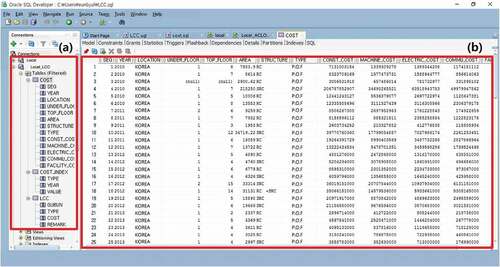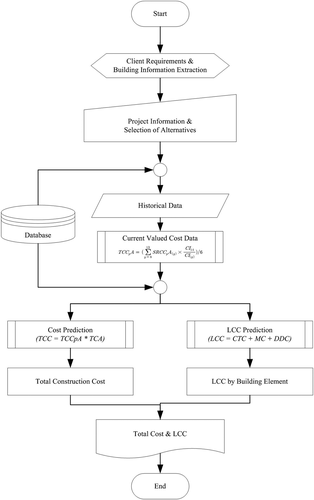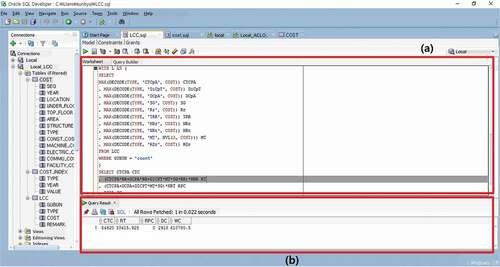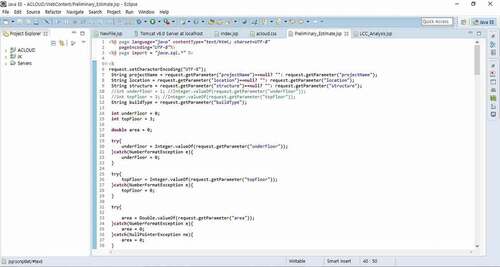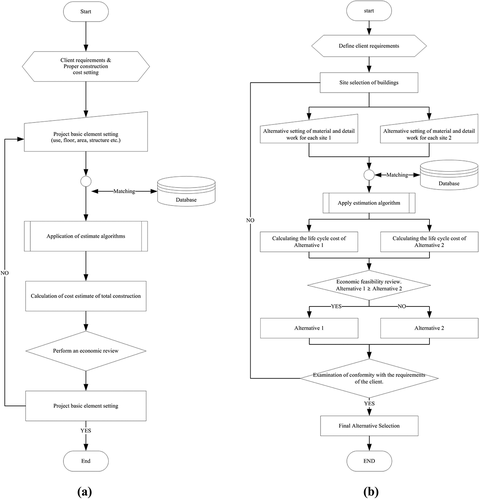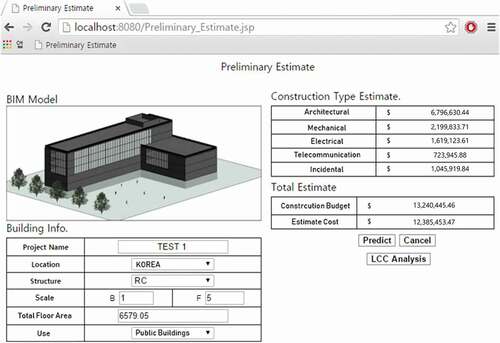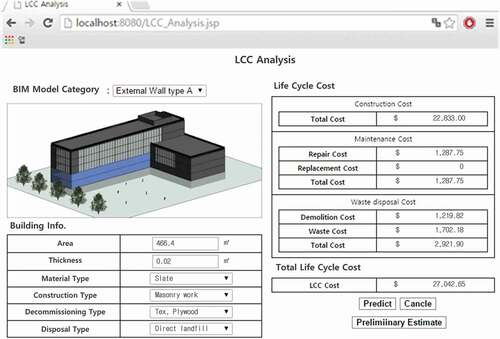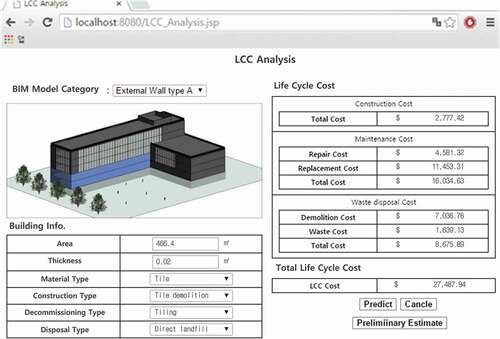 ?Mathematical formulae have been encoded as MathML and are displayed in this HTML version using MathJax in order to improve their display. Uncheck the box to turn MathJax off. This feature requires Javascript. Click on a formula to zoom.
?Mathematical formulae have been encoded as MathML and are displayed in this HTML version using MathJax in order to improve their display. Uncheck the box to turn MathJax off. This feature requires Javascript. Click on a formula to zoom.ABSTRACT
Prediction of construction cost and life-cycle cost through preliminary estimate is very important for the economic decision-making in the early phase of building projects. However, the conventional preliminary estimate has a high error range and low reliability because it relies only on the basic information of projects. In addition, the consideration of the life-cycle cost of the building is insufficient, causing problems such as budget shortage, inaccurate budgeting, and life-cycle cost increase. In this study, we propose a method of preliminary estimate based on BIM below the level of detail 2 and actual construction cost data to support the decision-making in the early design phase. To verify the proposed method, a web-based prototype was implemented and applied to three test cases. The range of error rate for three test cases was 1.93–7.16% (average error rate: 5.18%). It satisfies the criteria (−30% ~ +50%) of the “American Association of Cost Engineering”. As a result, the feasibility of the proposed model was validated. It is expected to be utilized as useful information in the decision-making occurring in the early design phase, and this allows for a rapid economic review of the design alternatives, a reduced LCC, and a shortened decision-making time.
1. Introduction
Decision-making among the participants of a construction project has become a factor determining the success or failure of such projects because buildings have become larger and more complex. Particularly in the life cycle of a construction project, the planning and design phases have the most significant impact on the whole project (Kaplan and Norton Citation2005), and major decisions like the outline of a building and the selection of design alternatives are made in these stages. In addition, preliminary estimation in the early design phase determines not only the feasibility of the project but also the total project cost, and the government often considers the preliminary cost estimate the upper cost limit for the project (Azman, Abdul-Samad, and Ismail Citation2013). The estimation methods based on the previous studies require much time, and their use is limited due to the problems resulting from limited information, low data reliability, and poor estimation accuracy. To address these problems, estimation methods using building information modeling (BIM) have been studied of late. As most of the BIM-based preliminary estimation methods, however, are based on the BIM models, through which quantity calculation is possible as the design progresses, they pose limitations in supporting the decision-making in the planning and schematic design phases. In addition, the decision-making in the early design phase affects the construction costs as well as the costs incurred by the maintenance and dismantling of building structures. Therefore, decisions should be made considering the life cycle cost (LCC). The current decision-making process, however, makes it difficult to reflect the economic aspects of the entire life cycle, and the decision-making depends solely on the designer’s experience, based on limited information (De Freitas and Delgado Citation2013). This has caused problems like exceeding the estimates due to design changes, increased maintenance costs, and budgeting difficulties.
To support the decision-making regarding the key elements of a construction project and the selection of design alternatives in the early design phase of the project, the scope of this study was limited to the BIM-based preliminary estimation in the early design phase.
In addition, this study proposes a method capable of predicting the LCC according to the design component alternatives as well as the existing construction costs, for accurate economic analysis. Here, LCC refers to the cost arising from the construction, maintenance, and dismantling and disposal phases. Towards this end, a database of actual cost data and cost estimation criteria was constructed and linked with the BIM model. Then a prototype was implemented for a comparison of the LCCs according to the design alternatives and the preliminary estimates of the entire building. The accuracy of the prototype was verified by comparing the preliminary estimates of three similar cases selected from actual construction cost data with the actual costs. In addition, the validity of the method of supporting the decision-making was confirmed based on the comparative analysis between the predicted LCCs for each design alternative.
2. Conventional approaches and limitations
2.1. Level of detail (LOD)
The BIM-based estimates differ in the accuracy of the estimates according to the BIM model details. The level of detail (LOD), which represents the LOD and steps of the BIM model, was first presented in 1976 in the field of computer graphics (Clark Citation1976). In setting up the LOD and conducting modeling in the course of the construction project, it is necessary to create a model that contains only the necessary information. If the LOD is set too high or too low, problems like overwork and rework, as well as lack of information will arise.
In the case of the 3D data model, a 1/100 scale for the planning and basic design process and a 1/50 scale for the practical design stage are applied (Properties Citation2009). In this case, expressions with finite details are difficult to express, so less than 1/50 expressions use 2D details. If this method is used, however, differences in data occur due to the missing objects in the 3D model, which causes problems in terms of the accuracy and reliability of the BIM-based estimation. To solve this problem, the detail level of the BIM model should be raised. The actual building type and material information can be determined from LOD 2. This, however, not only wastes cost and time by causing unnecessary modeling but is also difficult to apply to preliminary estimation because the detailed BIM model is constructed at the detailed design stage. The LOD is generally divided into 1 to 4 and may be expressed in a maximum of five steps (Abualdenien and Borrmann Citation2018) (refer to ). For the preliminary estimation in the planning stage at the beginning of the design, this study set out the estimation using the mid-level model of LOD 1 to LOD 2, including basic information like the project outline, area, volume, and spatial information.
Table 1. Necessary information according to the estimation work by design stage.
2.2. Preliminary estimation
2.2.1. Definition of preliminary estimation
The preliminary estimation conducted at the beginning of the construction project is an important tool for supporting the decision-making to determine the progress of the project (Barzandeh Citation2011). Estimation can be divided into budget estimation, estimation based on the design, and practice estimation based on the time of estimation. Estimation is also divided into preliminary estimation and detailed estimation based on the estimation contents by design phase. The methods used in preliminary estimation include the cost indices method, the cost capacity factor method, the factor estimation method, the parameter cost estimation method, etc. In preliminary estimation, however, different estimation results may be obtained and errors may occur due to the differences in the engineering experiences, perspectives, viewpoints, knowledge, agencies involved, estimation methods used, reliability of the collected information, and time of estimation (Wibowo and Wuryanti Citation2007).
2.2.2. Accuracy of estimation
Preliminary and detailed estimation have different purposes of use, required levels of accuracy, and accepted levels of errors according to each phase, and American Association of Cost Engineering (AACE) has developed a cost estimate classification system, as shown in (AACE Citation2016).
Table 2. Cost estimate classification matrix for process industries.
Generally, the existing estimation methods allow for an error rate of +50% to −30% or +30% to −15% through Hamilton’s approximate method, but it is difficult to use these error rates for actual construction. The preliminary estimation obtained at the initial stage of a construction project is the basis for establishing the project budget and is a very important factor for the feasibility and alternative reviews of the project, but it is difficult to accurately estimate the construction cost due to the lack of structured actual construction cost data. Also, the ratio of re-estimating the initial estimate is 94.7% (Ahn, Song, and Heo Citation2003). Therefore, it is necessary to construct a database for accurately estimating the construction cost and for reducing the frequency of rework by linking information according to the project progress.
2.3. Life cycle cost
The life cycle of a building involves all the processes involved in the life of the building, including planning and design, construction, maintenance, and dismantling and disposal. The total cost is defined as the LCC of the building. The LCC is divided into the planning and design cost, construction cost, operation and maintenance cost, and disposal cost.
Planning and design cost: Refers to the expenses required for construction planning, field survey, paper acquisition, and environmental management before the building construction, and includes the design cost and the necessary design technology.
Construction cost: Includes the costs incurred for contractor selection and construction contracts, and all the direct and indirect costs incurred for building construction, construction and site management, construction inspection, and construction support.
Operation and maintenance cost: The expenses incurred for building maintenance, such as the personnel and maintenance expenses for maintaining the performance and functions of the building to enable it to be used from after its completion until its demolition, as well as the gas and water expenses.
Waste disposal cost: Includes the costs incurred by dismantling and disposing of the wastes obtained from the dismantling of the building, and the costs of the use of environmental measures for preventing noise and dust during the dismantling of the building.
In this study, the costs incurred in the planning and design stages that are not directly affected by the selection of design alternatives were excluded. In addition, as shown in , the construction cost, repair and replacement cost, and dismantling and disposal cost, which differ by design alternative, were excluded, except for the common expenses like the general management expenses and the labor cost incurred during construction. Also, LCC prediction according to the design alternative was carried out.
2.4. BIM based preliminary estimation
Studies related to BIM-based estimation have been carried out from various perspectives, and estimation methods including that of the LCC rather than simple construction cost estimation have been studied of late. In this study, the existing researches related to the BIM-based project estimation are classified into four aspects.
To support the performance of building design, Vaidya et al. (Citation2009) proposed database construction methods for energy analysis and cost estimate automation based on commercial software. Leśniak and Zima (Citation2018) developed a relational database for the cost estimation model. A total of 173 construction projects were databased, and a final database was constructed using the case-based reasoning method, by establishing 14 relationships among the estimation variables.
For the studies on BIM modeling, Monteiro and Martins (Citation2013) proposed a modeling guideline for accurate quantity calculation in BIM-based design, minimizing the limitation of BIM-based estimation. Wu, Wang, and Wang (Citation2018) proposed a method of increasing the estimation accuracy through the use of an integrated model of extended three-dimensional analysis of building systems (ETABS) and BIM, to overcome the shortcoming of the lack of accurate information on the BIM structure.
In the review of the autocorrelation model by Cheung et al. (Citation2012), the use of a BIM-based autocorrelation estimation scheme using Google’s sketchup in the early stages of the project was proposed. In a similar study, Lee, Kim, and Yu (Citation2014) used the IFCXML file format to extract the information needed for estimation, and improved the accuracy and efficiency of the quotation work by performing building estimation based on BIM and ontology. In addition, domestic researches have been carried out to improve the estimation accuracy by coming up with estimates based on specific processes and sites, rather than estimating the total number of buildings. For example, the study of Yeom and Kim (Citation2014) confirmed the necessity of an estimation system specializing in high-rise buildings with large budgets, and developed an estimation system for exterior finishing work.
In the case of LCC studies, as the need for an economic review not only of the construction cost but also of the whole LCC has increased, studies on BIM-based LCC prediction rather than simple construction cost estimation using BIM are actively being conducted. Whyte and Scott (Citation2010) assisted the decision-making on the design alternatives in the design process by suggesting ways of predicting the LCC of a building by defining and integrating model information through appropriate BIM tools. In addition to predicting the overall LCC, Cheng and Ma (Citation2013) conducted research to help predict the cost incurred by building waste disposal through a BIM-based system, and to establish a waste treatment plan.
The current BIM-based estimation method, however, requires detailed modeling at a certain level because accurate automatic calculation of quantity is considered a priority. As the design information is limited in the initial stage of the design, however, it is difficult to estimate the BIM. Also, even if the quantity is calculated through detailed and accurate modeling, if the cost information is not accurate, a mistake may be made in the estimation. To increase the accuracy of the cost information, the standard cost or actual cost information is required, but it is difficult to directly apply the standard cost model to the actual project. In the case of the performance cost, not only is it limited to the collection of data; it is also difficult to grasp the accuracy of the information. In addition, as preliminary estimation itself deals mainly with the building’s material and construction costs, there are insufficient studies on the LCC incurred by the maintenance and dismantling of buildings.
3. Concept: method of bim- based preliminary estimation for decision-making
3.1. Performance data and cost calculation standard
3.1.1. Criteria for calculating the total construction cost estimate
In this study, among the various existing estimation methods, the cost index method, which estimates based on the historical construction cost data of similar projects performed in the past, was applied. The actual construction cost data, the most basic estimate, was utilized by Public Procurement Service in “Analysis of construction cost by type of public building 2008–2014” (Public Procurement Service of KOREA Citation2014). The construction cost index, which is used to convert past costs to current costs, was developed by “Korea Institute of Civil Engineering and Building Technology” and received “Statistics Korea” approval (General Statistics Approval No. 39701) (KICT Citation2018).
In the analysis of public construction cost analysis data, six kinds of analysis data were included (refer to ), and based on these data, similar-building filtering of the total construction cost estimate was conducted.
Table 3. Analysis types of construction cost by type of public building.
The construction cost index is used for the direct construction costs incurred for the materials, labor, equipment, etc. to be used for the construction, using data from Bank of Korea’s industry table and the producer price index (Ministry of Economy and Finance Citation2017). Construction Cost Research Center announced the monthly trends in the construction cost index as the production price index (100%) as of 2010 (refer to ).
Table 4. Average construction cost index by year.
3.1.2. Life cycle cost estimation criteria for design alternatives
In this study, an attempt was made to support early-stage decision-making by predicting the LCC by design alternative as well as estimating the total construction cost. Presented in this chapter are the criteria selected for estimating the LCC based on the results of the public building cost analysis that was conducted (refer to ). Each criterion was divided into the useful life, the repair cycle and yield, the waste treatment standard, and the real discount rate.
The useful life of a building is the duration of usefulness of the building. It is also called “content period” or “durability training,” and it is a training that can bring the expected effect according to the original building use and usage method. To estimate the LCC of a building, the useful life of the building should be utilized. In this study, the projected life expectancy of a building was estimated using “the standard service life and the useful life range table” (Ministry of Economy and Finance Citation2017). It is also important to know the accurate repair and replacement points to be able to predict the maintenance cost as part of the LCC by design alternative. To do this, the “Establishment Criteria for Long-Term Repair Plan” was used (Ministry of Land, Infrastructure and Transport Citation2018).
The LCC of a building also includes the cost of disposal of construction waste, so a criterion for waste disposal cost is needed. For this, the Ministry of Environment (Citation2016) selected the waste receipt fee defined in the “Waste Public Treatment Facility Transfer Fee” announced by the said ministry. In the case of construction waste, much of the waste is included in the general waste in the Waste Management Act. The Ministry of Environment divided waste into the objects to be landfilled and incinerated. The LCC is a future cost, so the future values must be converted to their present values. In this study, the discount rate was used to convert a future value to its present value. The discount rate is divided into a nominal discount rate that does not take into account the inflation rate, and a real discount rate that takes inflation into account. The real discount rate is the nominal discount rate minus the inflation rate, which is based on Bank of Korea’s deposit interest rate and consumer price inflation rate. The real discount rate, on the other hand, is calculated from 2008 to 2014 and is summarized in . The average real discount rate for 7 years is about 0.72%.
Table 5. Real discount rate.
3.2. Preliminary estimation method for decision making
3.2.1. Preliminary estimation of the total construction cost
Based on the actual construction cost data and the criteria for estimating the construction cost, estimation was carried out in the initial design stage. Based on the cost index method, the projected cost is estimated by applying the construction cost index based on the construction cost data for each type of public building in 2008–2013. In the case of the 2014 data, it is not used for preliminary estimation.
In the classification of the actual construction cost data, the cost of construction, electricity, communication, and other expenses, and the construction cost per m2, were analyzed. Next, the construction cost per unit area of the target construction was derived through general information like the construction scale, usage, structure, and floor area of the project outline. The construction cost per m2 of the target construction was estimated by applying the construction cost index, as in EquationEquations 1(1)
(1) and Equation2
(2)
(2) , and the total construction cost was calculated by substituting the total floor area.
where, TCCpA = target construction cost per area, SRCCpA(y) = similar-results construction cost per area, = cost index, and y = year.
where, TCC = target construction cost, TCCpA = target construction cost per area, and TCA = target construction area.
3.2.2. Life cycle cost estimation by design alternative
To support the decision-making at the early design stage, not only the overall construction cost but also the price information that can be compared with other price information are needed. The LCC scope is limited to the construction, maintenance, and dismantling and disposal phases, excluding the planning and design stage, to compare the costs incurred as a result of the decision. defines the cost data and the criteria for estimating the LCC for each step.
Table 6. Cost data and criteria for calculating the LCC by step.
The LCC is calculated by summing up the construction cost, maintenance cost, and dismantling and disposal cost according to the detailed work type of the design alternative, as shown in (refer to EquationEquation 3)(3)
(3) .
where, LCC = life cycle cost, CTC = construction type cost, MC = maintenance cost, and DDC = decommissioning and disposal cost.
The cost of the construction phase is estimated based on the construction cost and the construction area according to the detailed work of the design alternative. For estimating the construction cost according to the design alternative, the construction cost for each detail type of similar performance data was used. In EquationEquation 4(4)
(4) , the unit price of construction work per unit area is calculated using the construction cost per unit area and the construction cost index, and the construction area is multiplied by the construction cost index, as shown in EquationEquation 5
(5)
(5) , to obtain the total construction cost.
where, CTCpA = construction type cost per area, SRCTCpA(y) = similar-results construction type cost per area, CI = cost index, and y = year.
where, CTC = construction type cost, CTCpA = construction type cost per area, and CTA = construction type area.
In the maintenance of a building, repair and replacement can be done depending on the design alternatives during the life of the building. Therefore, the formula for calculating the maintenance cost can be obtained as the sum of the repair and replacement costs, as shown in EquationEquation 6(6)
(6) . Also, the equations for calculating the repair and replacement cost shows the Equation S1 and S2.
where, MC = maintenance cost, RC = repair cost, and RpC = replacement cost.
In the dismantling and disposal phase, the sum of the cost of dismantling the building and the cost of disposing of the waste after dismantling is calculated. The equation is the same as EquationEquation 7(7)
(7) . Also, the equations for calculating the repair and replacement cost shows the Equations S3 and S4.
where, DDC = decommissioning and disposal cost, DeC = decommissioning cost, and DiC = disposal cost.
4. Implementing the decision support method in early design stage
4.1. Overview of the BIM-based preliminary estimation system
shows a BIM-based preliminary estimation process.
The BIM model information is linked with the BIM-based project preliminary estimate prototype to extract the basic information of the project outline and BIM model from the repository server.
A database of the performance cost and reference data is built, and the preliminary estimation algorithm is defined by applying the calculation formula.
Connection with the database is established based on the extracted basic information, through system linkage.
The similar cost and standard data are estimated and applied to the algorithm to implement the BIM-based preliminary estimation system. Unlike the existing BIM-based estimation method, the BIM-based estimation method in this study supports the decision-making by providing the designer with the LCC according to the design alternative as well as the total construction cost by coming up with an estimate through the mass model at the initial design stage.
4.2. Establishment of a database for performance data and cost
The structure and contents of the database include the project basic information for similar-performance-data matching and the actual construction cost and the construction cost index for the preliminary estimation. The actual construction cost data include the construction, machinery, electricity, communication, and engineering (civil engineering) construction costs, and the construction cost for each detail type. In addition, they include criteria for establishing a long-term repair plan for predicting the LCC according to the detailed work type, and cost estimation criteria like the waste treatment standard, standard product, and real discount rate. For taking advantage of these data, the database was built using Oracle SQL Developer, which is currently the most common and reliable database management system (DBMS).
shows the process of database construction through Oracle SQL Developer. ) is the table tree constituting the database. It consists of the performance cost and the cost estimation criteria in the configuration screen of the table composed of a data header and data, through which similar performance data are matched.
4.3. Implementation of the BIM-based preliminary estimation system
The preliminary estimation system first grasps the client’s requirements and then applies these to the BIM model. The generated model is saved to the repository server, and the data needed for the estimation are parsed and delivered to the prototype system. The delivered data and the design alternative input data are then quoted through the database’s quotation algorithm.
For the implementation of the prototype system, a preliminary estimation algorithm is defined so that the estimates can be executed based on the basic information of the project and the designer’s design alternatives (refer to ). Based on the client’s requirements and the BIM model information, the designer selects the basic information of the project and the alternatives for each building site. The selected design contents are linked with the database to derive similar performance data. The derived data are assigned to the current value method to convert the past cost data to the current cost. The actual construction cost and the standardized data are then converted to LCC estimates.
The preliminary estimate quote algorithm was algorithmically coded using Oracle SQL Developer to associate it with the database. shows the algorithm coding screen, where (a) is a worksheet window that codes an equation and (b) is a window showing the coding result.
JAVA-based eclipse JSP was used to implement a Web-based user interface (UI) in conjunction with the built-in database and algorithm (refer to ). The prototype system UI is divided into a UI for the utilization of the preliminary estimate of the overall construction cost (refer to Figure S1) and a UI for forecasting the LCC by design alternative (refer to Figure S2).
4.3.1. BIM-based decision-making process
Through the implemented BIM-based project estimation system, the decision-making process of the early stage of designing the construction project is defined as shown in . Through this, decision-making such as that on the basic elements of the project and the detailed work in the planning and planning design stages will be supported.
) shows the process of determining the basic elements of a construction project. This process sets a proper construction cost according to the client’s requirements, and determines the basic elements, such as the purpose of the project, the number of floors, and the area, region, and structure. It then extracts the construction costs of similar projects in connection with the database, and applies estimation algorithms to derive the total construction cost. Thereafter, it performs an economic review through a comparison of the cost estimate and the proper construction cost. If the cost estimate exceeds the proper construction cost, or if a problem arises, measures should be taken to correct the basic elements so that the cost estimate will not exceed the proper construction cost.
The process of determining the alternatives of the materials and detailed works is shown in ). First of all, it defines the client’s requirements, selects the building parts (eg, the exterior wall, interior wall, ceiling, floor, and stairs), and enters the design alternatives on the materials and detailed works for each part. Next, it extracts the LCC estimation criteria according to the design alternative and the construction cost for each detailed work in connection with the database, and applies estimation algorithms to predict the LCC according to the design alternative. This process should be performed more than twice to compare the alternatives. Lastly, through a comparison, it determines if the derived alternative complies with client’s requirements, and then determines the final design alternative.
5. Verification of the decision-making support method in the early design stage
5.1. Preliminary estimation-based support for decision-making
5.1.1. Selection of verification targets and BIM modeling
The preliminary estimation of the total construction cost implemented in the prototype is tested to determine if it can provide accurate estimation data for decision-making in the early design phase. For accurate verification, the preliminary estimates formed through the completed construction cases were compared with the actual construction costs. The average KRW: USD exchange rate of 1,115.70 in 2018 was applied as a currency in this study (Ministry of Economy and Finance Citation2019).
Among the projects included in the data on “Analysis of 2014 Construction Expenses Classified by Public Facility,” three projects with similar use, size, structure, and location data were selected as verification targets. As shown in , the three projects were reinforced concrete buildings with five stories above the ground and one underground level used as public office facilities and located in Gyeonggi,-do, Daegu, and Incheon, respectively.
Table 7. Projects to be verified.
Each project building was modeled using Revit from Autodesk, one of the most widely used BIM tools, to conduct BIM-based project estimation through selected project data. The modeling of the building progressed to the mass model level of LOD1-LOD2, which is generally conducted at the planning and design stage (refer to ).
Table 8. BIM models of the buildings to be verified.
5.1.2. Results of the decision making support method based on the preliminary estimation
To verify the BIM-based estimation system, three BIM models were built and estimated. shows a screenshot of the application of the BIM model of the Kimpo City project in Test 1. The two other projects were also conducted in this way.
compares the estimated cost of the system with the actual construction cost of the actual project, and shows the error rate. The errors from the three tests were 6.46, 7.16, and 1.93%, respectively. The error range was 1.93–7.16%, and the average error rate was 5.18%. This implies that the BIM-based estimation method in this study has high accuracy, estimated to be between −30% and +50%, for the feasibility analysis specified in AACE, and has a less than 10% error rate.
Table 9. Results and error rates of the preliminary estimation method to be verified.
5.2. Verification of the decision-making support method through life cycle cost forecasting
5.2.1. Life cycle cost estimation guideline verification target and calculation criteria
Verification of the proposed LCC prediction method was conducted based on the model of Test 1 among the three projects that were previously modeled. In accordance with the decision-making process in this paper, some outer walls of the BIM model were selected, and the type of exterior material and the detailed work alternatives were set. summarizes the calculation criteria for alternative LCC.
Table 10. Design alternatives and LCC estimation criteria.
Test 1 is a reinforced-concrete structure with a life expectancy of 40 years according to the “basic contents training schedule,” and the cost that is the basis of the calculation is defined according to each alternative, as shown in .
Table 11. Defined costs based on the calculation criteria.
First of all, the construction cost by detail type is extracted from the project cost according to the basic elements and design alternatives (eg, actual construction cost), and is converted to the current cost through the construction cost index. In the case of the dismantling cost, the actual data on the existing project is not enough, and the method of dismantling according to each work type, and the cost, are applied using the standard part. Finally, the waste disposal cost is defined as the average value of the costs specified in the “designated waste public treatment facility import fee” announced by the Ministry of Environment.
shows the number of repair and replacement cycles occurring in the maintenance phase, determined by applying the repair cycle and the water recovery rate specified in “Criteria for the Establishment of a Long-Term Repair Plan” for the long-term repair plan among the estimation criteria defined in .
Table 12. Numbers of repairs and replacements.
5.2.2. Verification result of decision support measures through life cycle cost prediction
In this chapter, the BIM-based preliminary estimation system was used for validation to estimate the LCC by design alternative. shows the screen of the results derived by selecting masonry, as in design alternative 1, and inputting the calculation criteria based on this into the system. The screen as a result of entering the calculation criteria for the tile design of alternative design 2 is shown in .
summarizes the results of the LCC forecasts for each design alternative according to the stage, including the construction, repair, replacement, dismantling, and disposal costs. The cost of each design alternative shows that the construction cost accounts for more than 84% of the total LCC of design alternative 1, and that the proportions of the maintenance, disposal, and decommissioning costs are small (ie, 15.57%). The construction cost of design alternative 2 accounts for about 10.10% of the total LCC, and the maintenance, dismantling, and disposal costs account for the majority of the remainder (ie, 89.67%). A comparison of design alternatives 1 and 2 will show that design alternative 1 has a higher construction cost and lower maintenance and dismantling and disposal costs while design alternative 2 has a higher overall LCC. As a result of the prediction of the LCC according to the design alternative, it can be said that it is necessary to take into account not only the construction cost but also the whole LCC when examining the economics of the material at the initial design stage. Based on the verification results presented in this chapter, the validity of the decision-making method through LCC prediction was verified, and it can be concluded that the designer and the client can make the decision based on the LCC in the early design stage.
Table 13. LCC results by design alternative.
6. Conclusion
This study was carried out to support the decision-making in the early design phase through BIM-based preliminary estimation. As the decisions made in the early design phase have the most significant impact over the entire project period, it is very important to consider not only the construction cost but also the costs incurred in the post-construction stages in the decision-making process. In this regard, the previous studies related to BIM-based preliminary estimation and the LCC were analyzed to derive their limitations and confirm the research directions and differentiation.
The findings of this study can be summarized as follows. The analysis of the status of the previous studies revealed that in the research related to BIM-based preliminary estimation, an estimate is made based on the automatic quantification function of BIM, and thus, the higher the LOD of the model is, the more accurate the estimate. As the progress of the design is limited in the early design phase, however, its application cases are rarely available, and the research on the LCC is insufficient. Therefore, it is necessary to consider the LCCs of the design alternatives as well as the preliminary estimates of the total construction cost for supporting the decision-making in the early design phase.
The performance data and estimation criteria were defined, and calculation methods were proposed to support the decision-making through accurate preliminary estimation and LCC prediction. The preliminary estimation was done based on the actual data of the existing project and the building cost index, while the establishment criteria for the service life and the long-term repair plan, the designated waste public treatment facility bring-in commission, and the standards of construction estimation and real discount rate were additionally applied in the LCC estimation.
For the implementation of the decision-making support method in the early design phase, the prototype was implemented, and the process was defined based on the information of the BIM model. The prototype, which consists of a database and an estimation algorithm, enabled the preliminary estimation and LCC prediction through the BIM model via a Web-based portal system.
Verification of the decision-making support system was conducted to confirm the accuracy of the preliminary estimation method and the validity of the decision-making support method according to the LCC. The results revealed that the proposed preliminary estimation method in this study has high accuracy, and that the decision-making process considering the LCC is possible.
The decision-making support method in the early design phase proposed in this study helps provide the LCC based on accurate preliminary estimation and design alternatives, and supports the decision-making by building designers and owners. Therefore, it is expected to be utilized as useful information in the decision-making occurring in the early design phase, and this allows for a rapid economic review of the design alternatives, a reduced LCC, and a shortened decision-making time.
This study has limitations, however, in that it is difficult to make an estimate for a building type, which is not found in the constructed database, because the estimate was made based on the database on the performance data and estimation criteria. In addition, the estimation criteria were examined based on the standard suggested by the government, but the limited classification and scope pose difficulties in estimating the LCC. For the future work, there is a need to conduct research on the LCC estimation criteria and the construction of big data, which can proceed through the collection, management, and analysis of performance data.
Supplemental Material
Download MS Word (881 KB)Disclosure statement
No potential conflict of interest was reported by the authors.
Supplementary material
Supplemental data for this article can be accessed here.
Additional information
Funding
Notes on contributors
Jaewook Lee
Jaewook Lee, Ph.D., is an Associate Professor of the Department of Architectural Engineering at Sejong University in Seoul, Korea. His research interests lie in exploring the application of information technologies to architecture, which includes computer-aided architectural design and construction, Building Information Modeling (BIM), Intelligent Building Systems (IBS), collaborative design, and smart city. Dr. Lee also serves as the chief editor of KIBIM (Korean Institute of Building Information Modelling).
Hyuncheul Yang
Hyuncheul Yang has a BS in Interior Design from The Academic Credit Bank System of National Institute for Lifelong Education (NILE) and an MS in Architectural Engineering from Sejong University, Seoul, Korea. He is currently a Ph.D. candidate and his research interests include the application of Building Information Modeling (BIM), human behavior simulation, Artificial Intelligence (AI), and other relevant areas.
Jinkang Lim
Jinkang Lim has a BS and an MS in Architectural Engineering from Sejong University, Seoul, Korea. After his MS, he worked as a site engineer for the construction company Line Construction Co., and currently serving as CEO of a manufacturing company. His research interests include the application of Building Information Modeling (BIM), Life Cycle Cost (LCC) analysis, and other relevant areas.
Taehoon Hong
Taehoon Hong is an Underwood Distinguished Professor of the Department of Architecture and Architectural Engineering at Yonsei University. He is the Associate Editor of Renewable & Sustainable Energy Reviews, Elsevier, and Journal of Management in Engineering, ASCE. He is an editorial board member of Applied Energy, Elsevier as well as Energy and Buildings, Elsevier. He is also an Associate Editor of Sustainable Design and Construction, Frontiers in Built Environment. Dr. Hong’s current research topics include renewable energy system, energy performance, solar photovoltaic system, indoor environmental quality, and sustainable building.
Jimin Kim
Jimin Kim is an Assistant Professor of Architectural Engineering Program in the School of Architecture at Seoul National University of Science & Technology. Dr. Kim's current research topics include healthy and sustainable construction engineering and management, and decision support system, focusing on the human-environment-building interaction management system. Dr. Kim focused on the top-down management approaches to energy-economy field and bottom-up management approaches to human-oriented-energy and environment management in the field of construction and real estate.
Kwangbok Jeong
Kwangbok Jeong is an Associate Research Fellow of the Department of Industrial Policy Research at Construction & Economy Research Institute of Korea. Dr. Jeong’s current research topics include sustainable construction engineering and management, sustainable building, artificial intelligence, and decision support system.
References
- AACE. 2016. “Cost Estimate Classification System-As Applied in Engineering, Procurement and Construction for the Process Industries: TCM Framework: 7.3-Cost Estimating and Budgeting.” AACE International Recommended Practice No.18R-97. Morgantown, West Virginia.
- Abualdenien, J., and A. Borrmann. 2018. “Multi-LOD Model for Describing Uncertainty and Checking Requirements in Different Design Stages.” eWork and eBusiness in Architecture, Engineering and Construction: Proceedings of the 11th European Conference on Product and Process Modelling (ECPPM 2018), Copenhagen, Denmark.
- Ahn, Y. S., K. R. Song, and J. M. Heo. 2003. “Improving the Accuracy of Screening of Cost Estimating in Early Construction Project Phase.” Journal of the Architectural Institute of Korea Structure & Construction 19 (11): 133–140.
- Azman, M. A., Z. Abdul-Samad, and S. Ismail. 2013. “The Accuracy of Preliminary Cost Estimates in Public Works Department (PWD) of Peninsular Malaysia.” International Journal of Project Management 31 (7): 994–1005. doi:https://doi.org/10.1016/j.ijproman.2012.11.008.
- Barzandeh, M. 2011. “Accuracy of Estimating Techniques for Predicting Residential Construction Costs–a Case Study of an Auckland Residential Construction Company.” Report for Industry Project CONS No. 7819, Degree of Bachelor of Construction. http://hdl.handle.net/10652/1794
- Cheng, J. C., and L. Y. Ma. 2013. “A BIM-based System for Demolition and Renovation Waste Estimation and Planning.” Waste Management 33 (6): 1539–1551. doi:https://doi.org/10.1016/j.wasman.2013.01.001.
- Cheung, F. K., J. Rihan, J. Tah, D. Duce, and E. Kurul. 2012. “Early Stage Multi-level Cost Estimation for Schematic BIM Models.” Automation in Construction 27: 67–77. doi:https://doi.org/10.1016/j.autcon.2012.05.008.
- Clark, J. H. 1976. “Hierarchical Geometric Models for Visible Surface Algorithms.” Communications of the ACM 19 (10): 547–554. doi:https://doi.org/10.1145/360349.360354.
- De Freitas, V. P., and J. M. Delgado, Eds. 2013. Durability of Building Materials and Components. Vol. 3. Berlin, Germany: Springer Science & Business Media.
- Kaplan, R. S., and D. P. Norton. 2005. Creating the Office of Strategy Management. Boston, MA: Division of Research, Harvard Business School.
- KICT(Korea Institute of Civil Engineering and Building Technology). 2018. “Construction Cost Index.” http://kosis.kr/statHtml/statHtml.do?orgId=397&tblId=DT_39701_A002&vw_cd=MT_ZTITLE&list_id=397_39701&seqNo=&lang_mode=ko&language=kor&obj_var_id=&itm_id=&conn_path=MT_ZTITLE
- Lee, S. K., K. R. Kim, and J. H. Yu. 2014. “BIM and Ontology-based Approach for Building Cost Estimation.” Automation in Construction 41: 96–105. doi:https://doi.org/10.1016/j.autcon.2013.10.020.
- Leśniak, A., and K. Zima. 2018. “Cost Calculation of Construction Projects Including Sustainability Factors Using the Case Based Reasoning (CBR) Method.” Sustainability 10 (5): 1608. doi:https://doi.org/10.3390/su10051608.
- Ministry of Economy and Finance. 2017. “Enforcement Regulations of Corporate Tax Law Article15 (3).” http://www.law.go.kr/lsInfoP.do?lsiSeq=208115&efYd=20190320#0000
- Ministry of Economy and Finance. 2019. “Annual Average Exchange Rate.” http://www.index.go.kr/potal/main/EachDtlPageDetail.do?idx_cd=1068
- Ministry of Environment. 2016. “Designated Waste Public Treatment Facility Bring-in Commission.” http://www.law.go.kr/%ED%96%89%EC%A0%95%EA%B7%9C%EC%B9%99/%EC%A7%80%EC%A0%95%ED%8F%90%EA%B8%B0%EB%AC%BC%EA%B3%B5%EA%B3%B5%EC%B2%98%EB%A6%AC%EC%8B%9C%EC%84%A4%EB%B0%98%EC%9E%85%EC%88%98%EC%88%98%EB%A3%8C
- Ministry of Land, Infrastructure and Transport. 2018. “Enforcement Rule of Apartment Housing Management Act - Criteria for Establishing Long-term Repair Plans.” http://www.law.go.kr/%EB%B2%95%EB%A0%B9/%EA%B3%B5%EB%8F%99%EC%A3%BC%ED%83%9D%EA%B4%80%EB%A6%AC%EB%B2%95%EC%8B%9C%ED%96%89%EA%B7%9C%EC%B9%99
- Monteiro, A., and J. P. Martins. 2013. “A Survey on Modeling Guidelines for Quantity Takeoff-oriented BIM-based Design.” Automation in Construction 35: 238–253. doi:https://doi.org/10.1016/j.autcon.2013.05.005.
- Properties, S. 2009. BIM Requirement 2007, Volume 7: Quantity Take-off. Finland.
- Public Procurement Service of KOREA. 2014. “Analysis of Construction Expenses Classified by Public Facilities 2008-2014.” https://www.pps.go.kr/bbs/selectBoardList.do?boardId=PPS045
- Vaidya, P., L. Greden, D. Eijadi, T. McDougall, and R. Cole. 2009. “Integrated Cost-estimation Methodology to Support High-performance Building Design.” Energy Efficiency 2 (1): 69–85. doi:https://doi.org/10.1007/s12053-008-9028-4.
- Whyte, A., and D. Scott. 2010. “Life-cycle Costing Analysis to Assist Design Decisions: Beyond 3D Building Information Modelling.” Proceedings of the 13th International Conference on Computing in Civil and Building Engineering 2010 (ICCCBE 2010). Nottingham, UK: Nottingham University Press.
- Wibowo, A., and W. Wuryanti. 2007. “Capacity Factor Based Cost Models for Buildings of Various Functions.” Civil Engineering Dimension 9 (2): 70–76.
- Wu, C. L., K. C. Wang, and W. C. Wang. 2018. “A BIM-based Conceptual Cost Estimation Model considering Structural Analysis and Design.” Proceedings of the 35th International Symposium on Automation and Robotics in Construction. Vol. 35, 1–8. Bratislava, Slovakia: IAARC Publications.
- Yeom, D. J., and Y. S. Kim. 2014. “Development of an Approximate Estimate System for Exterior Finishing Works of Super High-rise Buildings.” Journal of the Architectural Institute of Korea Structure & Construction 30 (7): 97–104. doi:https://doi.org/10.5659/JAIK_SC.2014.30.7.97.



